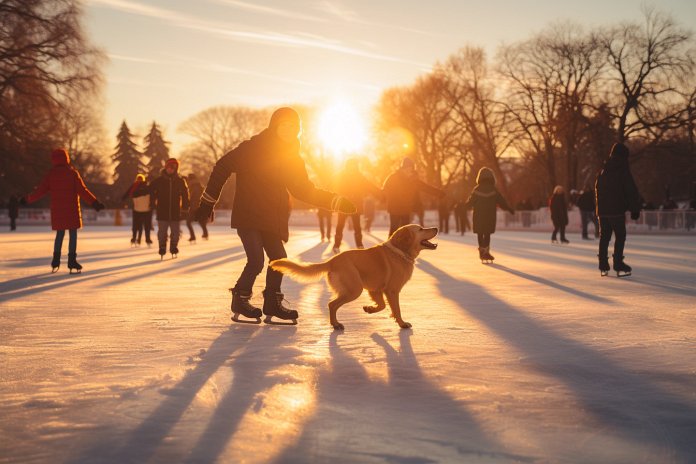
With the Stanley Cup playoffs happening, many households are watching ice hockey. The Colorado Avalanche is a popular team with a dog mascot. It’s amusing to think of a dog ice skating! Dogs are good at physical activities, but can they ice skate? It might depend on the dog.
Signs Your Dog Likes Skating
There isn’t much information about dogs ice skating, but we know how a dog acts when they enjoy something. If your dog seems physically relaxed, they are probably at ease. Look at their ears, mouth, and posture to see if they are truly relaxed. You might see them wagging their tail and even trying to run or jump. Although dogs can’t verbally express their feelings, you should know your dog well enough to tell if they are happy, scared, or sad. If they seem to be enjoying themselves, that’s a good sign!
If your dog is scared, don’t push them to do something they don’t want to do. Dogs can become unpredictable when scared, and their safety is important. If your dog is scared, they might cower, back away, tuck their tail, bark aggressively, growl, shake, or try to hide. No matter what they do, if they show fear, stop immediately.
Body Language
Here are signs that your dog is having fun on the ice:
– Jumping up
– Wagging tail
– Ears up
– Play bowing
Here are signs that your dog is scared of the ice:
– Cowering
– Backing away
– Tucking tail between legs
– Barking aggressively
– Growling
– Shaking
History of Dogs and Ice Skating
Ice skating originated in Scandinavia around 1000 BCE. Skates were made from animal bones initially, and metal skates were introduced later. In 1850, the all-steel skate was introduced, and improvements have been made since then. Skating has different forms like figure skating, speed skating, and ice hockey. It has been popular for many years and is a part of the Winter Olympic games.
There isn’t much information on dogs ice skating, but there are cute videos of dogs attempting to skate online.
Science Behind Dogs Ice Skating
Dogs are good at physical activities, but there isn’t much scientific information on dogs ice skating. Some dogs are better suited for the cold based on their fur type, size, weight, and other factors. Dogs have a circulatory system in their paws that helps prevent freezing. It’s unclear if this would help them glide on ice.
Training Your Dog to Ice Skate
Training a dog to ice skate is a challenging task that depends on their temperament. Some dogs might enjoy sliding on ice, while others may not. Dogs are intelligent and can be trained to do various tricks, so it’s possible to train them to skate. However, there aren’t many established methods for training dogs to ice skate. Some owners have had success using treats as rewards. Safety is crucial, and it’s important to check the ice’s thickness before attempting to skate with your dog to avoid accidents.
In conclusion
, whether dogs can ice skate depends on the individual dog and their desire to glide on ice. Regardless, prioritize safety and have fun.“Can dogs actually ice skate? It depends on your dog and if they want to glide gracefully around the ice.”

Tips & Things to Know
1️⃣ Pay attention to your dog’s body language: Look for signs of relaxation such as relaxed ears, mouth, and posture, wagging tail, and playful behavior. If your dog shows signs of fear or discomfort, such as cowering, backing away, and aggressive behavior, it’s important to stop immediately and ensure their safety.
2️⃣ Understand the limitations and considerations: Dogs have different physical abilities and temperaments, so not all dogs may enjoy or be suitable for ice skating. Consider factors such as your dog’s fur type, size, weight, and overall comfort in cold temperatures. Additionally, it’s crucial to assess the safety of the ice before attempting to skate with your dog to avoid accidents or injuries.
3️⃣ Training your dog to ice skate may be challenging: While dogs are intelligent and can be trained to do various tricks, there isn’t much information or proven methods for training dogs to ice skate. Some dog owners have had success using treats as a motivator, but it’s essential to prioritize safety and consider whether it is a safe and suitable activity for your dog.
Frequently Asked Questions, Answered ✅
1. How can you tell if your dog is enjoying ice skating?
– Look for signs of relaxation such as relaxed ears, mouth, and posture, wagging tail, and attempts to run or jump.
2. What are some signs that indicate your dog is scared of ice skating?
– Cowering, backing away, putting tail between legs, barking aggressively, growling, shaking, or trying to hide.
3. What is the history of dogs and ice skating?
– Ice skating began around 1000 BCE in Scandinavia, and dogs have been seen in cute videos attempting to skate, but there is not much information available about dogs and ice skating.
4. Is there any scientific evidence supporting dogs’ ability to ice skate?
– There is not much information on dogs ice skating, but dogs’ paws have a different circulatory system that helps prevent freezing. However, it is unclear if this would help them glide on ice.
5. Can dogs be trained to ice skate?
– It depends on the dog’s temperament, but some dogs may be able to be trained to skate. Treats and positive reinforcement may be effective, but it is important to ensure the safety of both the dog and the ice before attempting to teach them to skate.